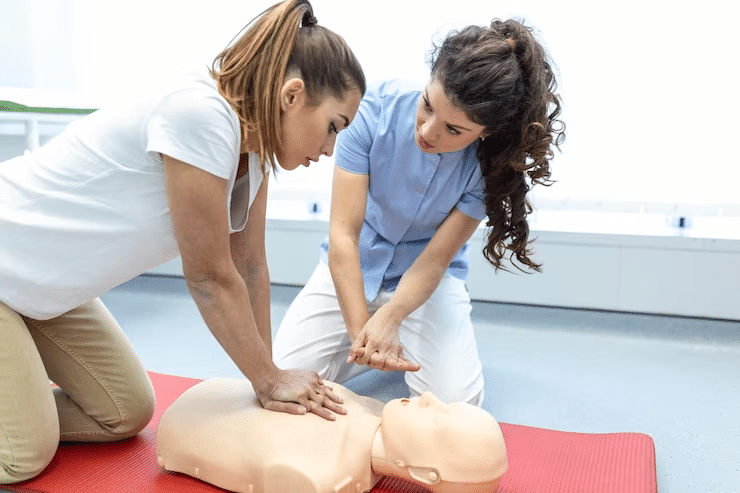Introduction
In today's fast-paced workplace, safety and security is extremely important. Organizations are increasingly recognizing the importance of developing a risk-free room for employees. Among the most crucial parts of workplace security training is initial help and mouth-to-mouth resuscitation (Cardiopulmonary Resuscitation) training courses. These courses not just equip workers with essential life-saving abilities but likewise cultivate a society of safety and security within the organization. In this short article, we will delve into the myriad reasons why workplace safety and security training ought to consist of first aid and mouth-to-mouth resuscitation training courses, underscoring their value in enhancing office safety.
Why Work environment Security Training Should Consist Of Emergency Treatment and Mouth-to-mouth Resuscitation Courses
The combination of emergency treatment and mouth-to-mouth resuscitation programs into workplace security training has significant benefits. They furnish employees with the expertise and skills needed to react effectively to medical emergencies, decrease recuperation time for injured people, and potentially conserve lives. Additionally, having actually trained personnel on-site can infuse self-confidence among staff members and comfort them that their health is prioritized.

Understanding Very first Aid
First help describes the immediate care given to a private struggling with a small or major ailment or injury until expert medical help arrives. Understanding basic first aid principles can make a substantial difference in emergency situations.
Key Components of First Aid
Assessment: The capability to assess a circumstance rapidly can help determine the ideal actions needed. Stabilization: Recognizing how to maintain a hurt individual prevents further harm. Communication: Efficiently communicating with emergency services is crucial for timely assistance.The Significance of CPR
CPR is a life-saving method made use of in emergencies when someone's heart beat or breathing hltaid011 First Aid Training has stopped. It entails upper body compressions and rescue breaths to keep blood circulation and oxygenation up until specialist help arrives.
How CPR Works
- Chest Compressions: These assist flow blood throughout the body. Rescue Breaths: These supply oxygen to the lungs.
Benefits of Emergency treatment and CPR Certification
Obtaining an emergency treatment certificate or completing mouth-to-mouth resuscitation training courses features numerous benefits, both for individuals and organizations.
Enhanced Worker Confidence: Staff members feel a lot more protected recognizing they have life-saving skills. Reduced Healing Time: Quick action via emergency treatment can bring about better outcomes for injured individuals. Compliance with Regulations: Several sectors call for licensed personnel as part of their health and safety regulations.Creating a Culture of Safety And Security Via Training
Implementing emergency treatment and CPR training promotes a society that prioritizes staff member health.
Encouraging Teamwork
Training sessions usually entail team-building exercises that boost cooperation amongst employees.
Building Trust fund Between Workers and Management
When administration buys employee training, it shows dedication to their wellness, bring about raised morale.
First Help Flows vs. CPR Courses: What's the Difference?
While both sorts of programs are important, they focus on various skill sets.
First Help Courses
These programs cover a wide variety of subjects beyond simply cardiac emergencies, including:
- Wound care Burns Choking
CPR Courses
CPR programs particularly focus on methods connected to heart attack circumstances, emphasizing:
- Adult CPR Child/ baby resuscitation Use of an Automated External Defibrillator (AED)
Choosing the Right Training Provider
Not all training providers are developed equal; therefore, picking one that satisfies your organization's needs is critical.
Accreditation Matters
Ensure that your selected service provider supplies accredited programs acknowledged by pertinent authorities.
Instructor Experience
Consider teachers' qualifications; knowledgeable trainers commonly give richer knowing experiences via real-world examples.
Incorporating Emergency treatment right into Office Security Policies
Organizations must incorporate first aid requirements right into their more comprehensive safety policies CPR courses with certifications for extensive coverage.
Regular Training Updates
Conducting regular refresher courses ensures that knowledge remains existing among employees.

Creating Emergency Feedback Plans
Having clear strategies in place can direct experienced personnel throughout emergencies.
Legal Ramifications of Emergency treatment Training in the Workplace
Employers have legal duties pertaining to office safety; applying first aid training can aid minimize dangers associated with non-compliance.

Negligence Claims
Failure to supply adequate training may leave employers at risk to legal actions if an occurrence occurs due to lack of preparedness.
FAQ Section
What is consisted of in a normal first aid course?- A typical emergency treatment course includes guideline on assessing injuries, treating wounds, managing burns, dealing with choking cases, and carrying out mouth-to-mouth resuscitation if necessary.
- Most CPR training courses last in between 4-- 6 hours depending on whether it's basic or innovative training.
- While not always legally mandated, having actually accredited personnel can significantly improve office safety standards.
- Many accredited companies supply on-line revival alternatives for first aid certificates that include assessments by means of video clip conferencing.
- Yes, industries such as building and construction, health care, education and learning, and production frequently have regulatory requirements demanding qualified employees on site.
- It's recommended that workers take part in correspondence course every two years or sooner if there are substantial modifications in treatments or regulations.
Conclusion
To sum up, integrating first aid and CPR into office safety and security training is not simply a choice however a need in today's work environments where emergency situations can arise anytime. Organizations benefit immensely from having trained employees ready to react properly during situations while cultivating an environment where worker health takes precedence over all else. Therefore, it comes to be obvious why work environment safety training should include first aid and CPR courses-- they save lives while advertising a proactive strategy towards health and safety criteria within companies throughout numerous sectors.
By prioritizing such necessary training initiatives-- emergency treatment certifications acquired with respectable companies together with sensible hands-on experience-- companies can significantly boost their general emergency preparedness degrees while also developing more powerful groups with the ability of taking on any scenario head-on!